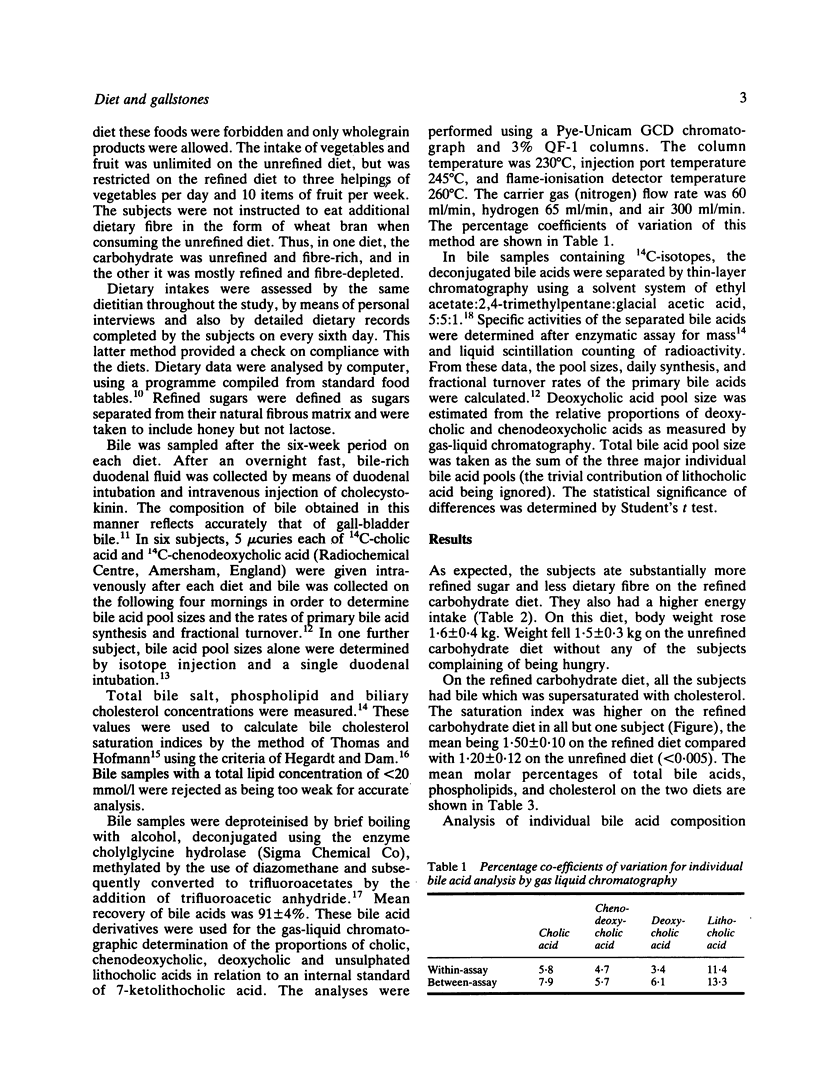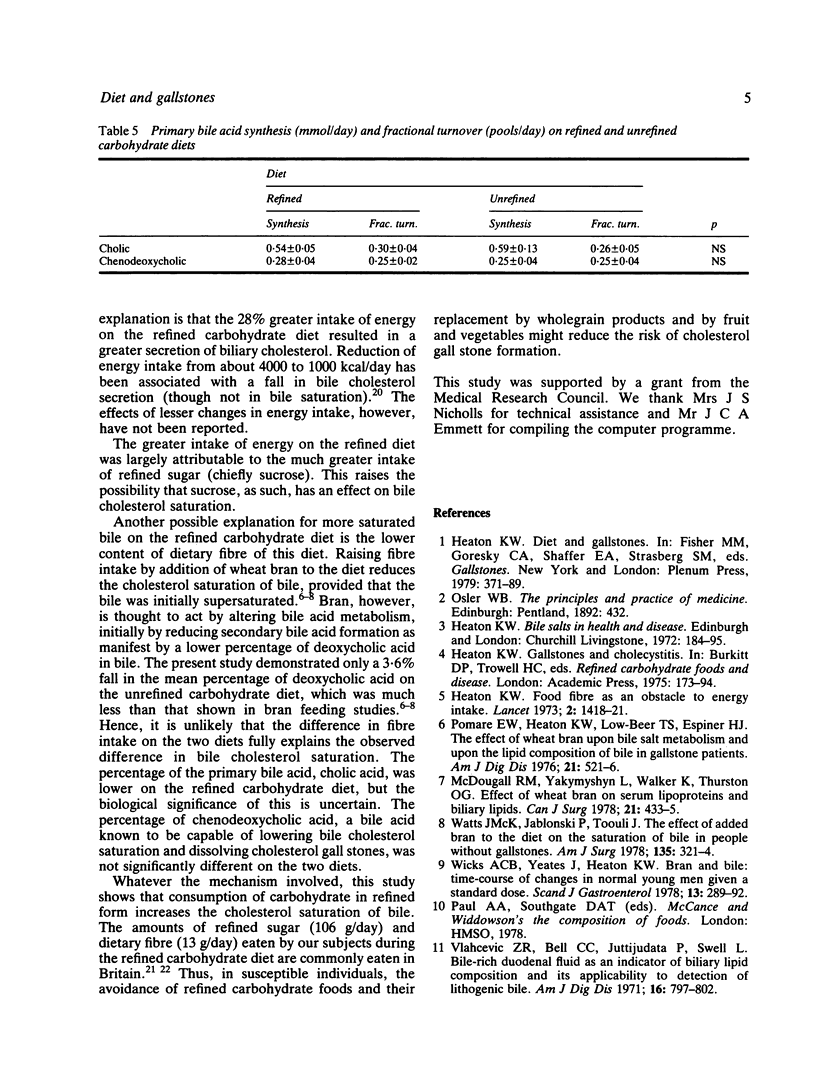Abstract
It has been suggested that consumption of refined carbohydrate foods (notably sugar and white flour) increases bile cholesterol saturation and hence the risk of cholesterol gall stone formation. To test this hypothesis, 13 subjects with probable cholesterol gall stones ate refined and unrefined carbohydrate diets, each for six weeks in random order. On the refined carbohydrate diet, subjects ate more refined sugar (mean = SEM: 106 +/- 7 vs 6 +/- 1 g/day, p less than 0.001), less dietary fibre (13 +/- 1 vs 27 +/- 3 g/day, p less than 0.001), and had a higher energy intake (9.17 +/- 0.66 vs 7.16 +/- 0.64 MJ/day, p less than 0.001). After each diet, the lipid composition of duodenal bile and bile acid kinetics was determined. The cholesterol saturation index of bile was higher on the refined carbohydrate diet in all but one subject, with a mean value of 1.50 +/- 0.10 compared with 1.20 +/- 0.12 on the unrefined diet (p less than 0.005). On the refined carbohydrate diet, bile contained relatively less cholic acid and slightly more deoxycholic acid. There were, however, no significant differences in total or individual bile acid pool sizes. There were also no differences in the rates of primary bile acid synthesis or fractional turnover on the two diets. Consumption of carbohydrate in refined form increases bile cholesterol saturation. The risk of gall stones might be reduced by avoidance of refined carbohydrate foods.
Full text
PDF




Selected References
These references are in PubMed. This may not be the complete list of references from this article.
- Bennion L. J., Grundy S. M. Effects of obesity and caloric intake on biliary lipid metabolism in man. J Clin Invest. 1975 Oct;56(4):996–1011. doi: 10.1172/JCI108180. [DOI] [PMC free article] [PubMed] [Google Scholar]
- Bolton C. H., Low-Beer T. S., Pomare E. W., Wicks A. C., Yeates J., Heaton K. W. A simplified procedure for the analysis of cholesterol, phospholipids and bile salts in human bile. Clin Chim Acta. 1978 Feb 1;83(1-2):177–181. doi: 10.1016/0009-8981(78)90222-x. [DOI] [PubMed] [Google Scholar]
- Bruusgaard A. Quantitative determination of the major 3-hydroxy bile acids in biological material after thin-layer chromatographic separation. Clin Chim Acta. 1970 Jun;28(3):495–504. doi: 10.1016/0009-8981(70)90078-1. [DOI] [PubMed] [Google Scholar]
- Carey M. C., Small D. M. The physical chemistry of cholesterol solubility in bile. Relationship to gallstone formation and dissolution in man. J Clin Invest. 1978 Apr;61(4):998–1026. doi: 10.1172/JCI109025. [DOI] [PMC free article] [PubMed] [Google Scholar]
- Duane W. C., Adler R. D., Bennion L. J., Ginsberg R. L. Determination of bile acid pool size in man: a simplified method with advantages of increases precision, shortened analysis time, and decreased isotope exposure. J Lipid Res. 1975 Mar;16(2):155–158. [PubMed] [Google Scholar]
- Heaton K. W. Food fibre as an obstacle to energy intake. Lancet. 1973 Dec 22;2(7843):1418–1421. doi: 10.1016/s0140-6736(73)92806-7. [DOI] [PubMed] [Google Scholar]
- Klaassen C. D. Gas-liquid-chromatographic determination of bile acids in bile. Clin Chim Acta. 1971 Nov;35(1):225–229. doi: 10.1016/0009-8981(71)90315-9. [DOI] [PubMed] [Google Scholar]
- LINDSTEDT S. The turnover of cholic acid in man: bile acids and steroids. Acta Physiol Scand. 1957 Sep 17;40(1):1–9. doi: 10.1111/j.1748-1716.1957.tb01473.x. [DOI] [PubMed] [Google Scholar]
- McDougall R. M., Yakymyshyn L., Walker K., Thurston O. G. Effect of wheat bran on serum lipoproteins and biliary lipids. Can J Surg. 1978 Sep;21(5):433–435. [PubMed] [Google Scholar]
- Pomare E. W., Heaton K. W., Low-Beer T. S., Espiner H. J. The effect of wheat bran upon bile salt metabolism and upon the lipid composition of bile in gallstone patients. Am J Dig Dis. 1976 Jul;21(7):521–526. doi: 10.1007/BF01464757. [DOI] [PubMed] [Google Scholar]
- Southgate D. A., Bingham S., Robertson J. Dietary fibre in the British diet. Nature. 1978 Jul 6;274(5666):51–52. doi: 10.1038/274051a0. [DOI] [PubMed] [Google Scholar]
- Thomas P. J., Hofmann A. F. Letter: A simple calculation of the lithogenic index of bile: expressing biliary lipid composition on rectangular coordinates. Gastroenterology. 1973 Oct;65(4):698–700. [PubMed] [Google Scholar]
- Vlahcevic Z. R., Bell C. C., Jr, Juttijudata P., Swell L. Bile-rich duodenal fluid as an indicator of biliary lipid composition and its applicability to detection of lithogenic bile. Am J Dig Dis. 1971 Sep;16(9):797–802. doi: 10.1007/BF02239307. [DOI] [PubMed] [Google Scholar]
- Watts J. M., Jablonski P., Toouli J. The effect of added bran to the diet on the saturation of bilein people without gallstones. Am J Surg. 1978 Mar;135(3):321–324. doi: 10.1016/0002-9610(78)90059-4. [DOI] [PubMed] [Google Scholar]
- Wicks A. C., Yeates J., Heaton K. W. Bran and bile: time-course of changes in normal young men given a standard dose. Scand J Gastroenterol. 1978;13(3):289–292. doi: 10.3109/00365527809179822. [DOI] [PubMed] [Google Scholar]


